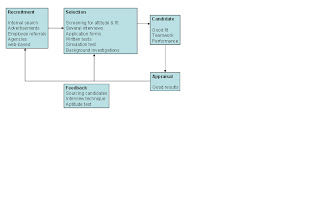Working with a organisation recently it was oserved that over the past two years staff turnover rates were well above the industry average. This was leading to increased recruiting, selection and training costs. In addition the high turnover rate was disrupting the efficient running of the organisation with knowledgeable and experienced staff leaving and replacements being sought.
In exit interviews the main reasons stated for leaving was an inability to “fit in” with the company culture and that the compensation did not compare to market rates. The selection process was being reviewed to determine if it is contributing to the turnover.
Analysis
In determining the cause of the high turnover all aspects of the human resources management (HRM) were reviewed uncovering that the root cause was the selection processes. The ineffective selection process resulted in staff being hired that did not fit culturally with the organisation. In addition to the high turnover the lack of cultural fit was potentially causing absenteeism and low productivity although these had yet to be researched. Pfeffer (1998) has suggested that recruiting people that have a cultural fit with the organisation leads to increased profits.
Issues with the selection process were a narrow search for candidates, no screening for cultural fit, no clarity on critical behaviours and attitudes, conducting only one interview and not assessing the results of the selection process. Analysing each of these issues in turn provided support for the premise that hiring for cultural fit is key to reducing high turnover.
Figure 1: Issues with the selection process
Sourcing candidates from a wider search would increase the chances finding the candidate with the best fit. Organisation such as Southwest Airlines and Subaru source large numbers of applications and interview a significant proportion in order to have the highest probability of sourcing the right candidate (Pfeffer 1998).
The reason for leaving of “not fitting in” highlighted that the values and assumptions of the candidates did not align with those of the organisation. To ensure better fit it was recommended that compatible values should be identified in the selection process. Personality and cultural traits should be screened for as these cannot be taught however skills can be taught. Candidates who are sociable and cooperative would support the high level of teamwork required. It was proposed that when people work in organisations that have a culture that fits with their values, they are more likely to be satisfied and productive.
Due to the tight labour market there is a tendency to settle for the first applicant with the right skills however this approach is unlikely to identify the values and behaviours that will provide a suitable fit with the corporate values. Conducting only one interview will not identify the teamwork and presentation skills required in all roles. Companies that value their staff require candidates to proceed through several interviews and a rigorous selection procedure. Not gathering feedback on the selection process leads to a repetition of the problem. A number of months after the selection it should be possible to assess the quality of the selection process by reviewing each component.
Although the organisation had a policy of paying market rates this does not appears to be attracting the right candidates. We argued that if organisational want to attract the highest performers it needs to have compensation that is substantially above market rates.
Improvement Planning
Selecting candidates based on cultural fit rather than the first applicant with the right skills will ensure lower turnover, lower absenteeism and improved productivity. The exit interviews support this with staff leaving because they don’t fit in. For the model to be effective all aspects of the model must be integrated simultaneously in order to derive business value. Although these could potentially improve the selection process they are outside the scope of this improvement plan and were analysed at a later date.
In recommending improvements we recommended a model for hiring the right people that included having a large number of applicants, screening for cultural fit and attitude, being clear about the most critical skills and behaviours, using several rounds of screening and assessing the process. A more structured process would be supported by the level of formalisation in the organisation.
The number of sources for candidates can be increased by utilising sources such as internal searches, advertisements, employee referrals, employment agencies, and web-based advertising. Although web-based advertising has a wide reach it generates many unqualified candidates.
As a example companies like Southwest Airlines prefer to hire without previous industry experience and select based on attitude alone to achieve cultural fit. This approach did not fit with the organisation as many of the roles are highly technical requiring five to ten years industry experience. A more appropriate approach would be to select for a combination of experience and attitude.
A more lengthy selection process would ensure that those who are hired have been carefully scrutinised and are committed to the role. The selection process should involve at least three interviews with the candidate’s supervisor, manager and HR. Other selection devices could include application forms, written tests, performance-simulation tests and background investigations. This will increase the resources expended on selection however given the costs of replacement this is justified.
In order to improve the selection process all components would be validated against the subsequent performance of the people selected. The HR department would manage this feedback process with the process being refined and developed based on these reviews.
Figure 2: New selection process
Selecting candidates based on their cultural fit to the organisation improves their ability to work within the team and improves performance. With such critical functions it is important to have the "right" team in place and time spent recruiting will improve performance in the long term.


No comments:
Post a Comment